Exotic lovers will be delighted with this plant. Dewdrop - a charming predator that feeds on insects, always shines and shimmers in the sun thanks to droplets of moisture on the leaves. This indoor flower requires special care conditions.
Material Content:
Sundew plant: types, varieties and description
Dewdrop is a carnivorous, carnivorous plant that belongs to the vast family of Dewdrops (Droseraceae). This perennial herb has healing properties, it is collected during flowering to treat cough, fever and eye diseases. It is found on all continents except Antarctica, and a total of 187 plant species are known.
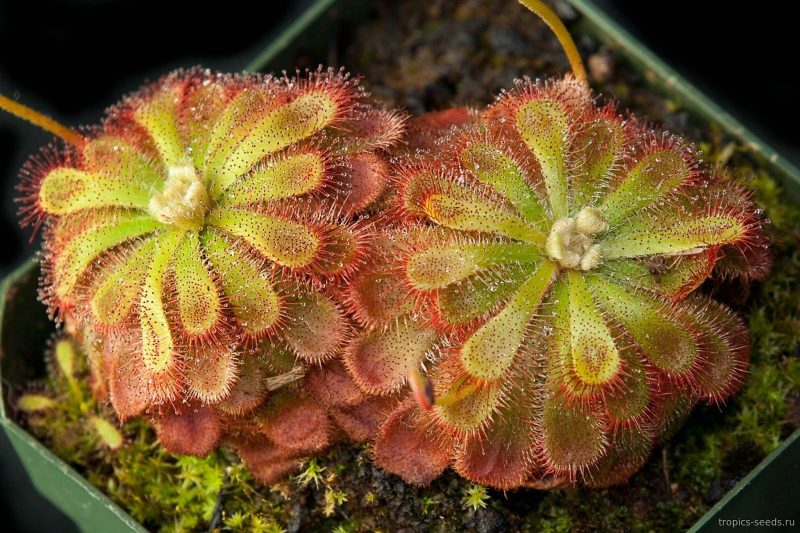
Here are some of them:
- Dewdrop is round-leaved - its rounded leaves with a diameter of about 2 cm grow on long petioles. Above and along the edges they are seated with red glandular hairs that secrete a sticky liquid. Leaves are spread on the surface of the soil. Blooms in summer with small white flowers that grow on long peduncles.
- The English sundew has a height of no more than 25 cm. Its linearly oblong leaves on the petioles are collected in a basal rosette.
- Intermediate sundew is a small plant up to 8 cm high. The leaves are arched and curved, have a lanceolate shape and glandular hairs.
- Dewdrop threadlike - grows up to half a meter, its beautiful thin leaves shimmering in the sun.
- Adele Rosyanka is an unpretentious large plant with lanceolate leaves. It does not tolerate frost, but loves coolness.
In indoor conditions, the Cape sundew (Drosera capensis) is most often grown, which is unpretentious in care and is a long-liver.
The plant got its name thanks to droplets of sticky liquid, which its leaves are always covered with. In appearance, they resemble dew, but in fact, it is something like gastric juice. This sticky fluid contains special enzymes that attract gullible insects that paralyze them and then digest them.
An insect adhering to the leaf, trying to free itself, breaks free. In response to this, the sheet is folded, covering the victim from all sides. The medium-sized insect is digested by the plant for several days, and its chitinous shell, legs and antennae remain intact. Then the sheet unfolds again and waits for a new victim.
Where does the sundew grow
The place of growth of predatory plants are wetlands, sandstones or mountains. They prefer scarce soil, as all nutrients come from captured insects. Many species are listed in the red books of the states in which they grow.
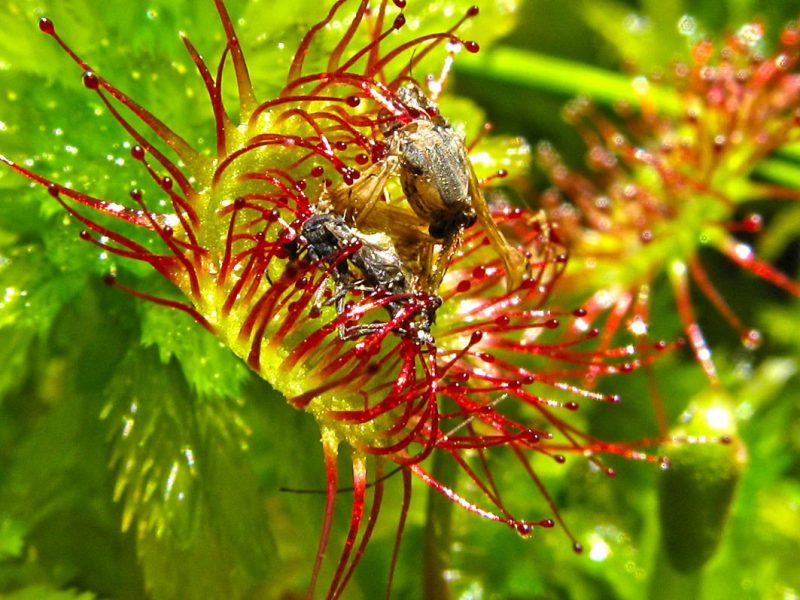
- In Russia there are only four species of sundews: round-leaved, English, obovate and intermediate.
- The Australian sundews that live in the Queensland rainforests are known, among them there are interesting dwarf species.
- The representative of the forests of South Africa - the royal sundew. Of all the varieties, it has the largest leaves, which sometimes reach more than half a meter in length.
- Filamentous sundew is growing in the USA.
Features of growing a predator plant
Growing sundews has nothing to do with caring for other plants. Special requirements apply to soil, watering, lighting, and even to a flower pot.
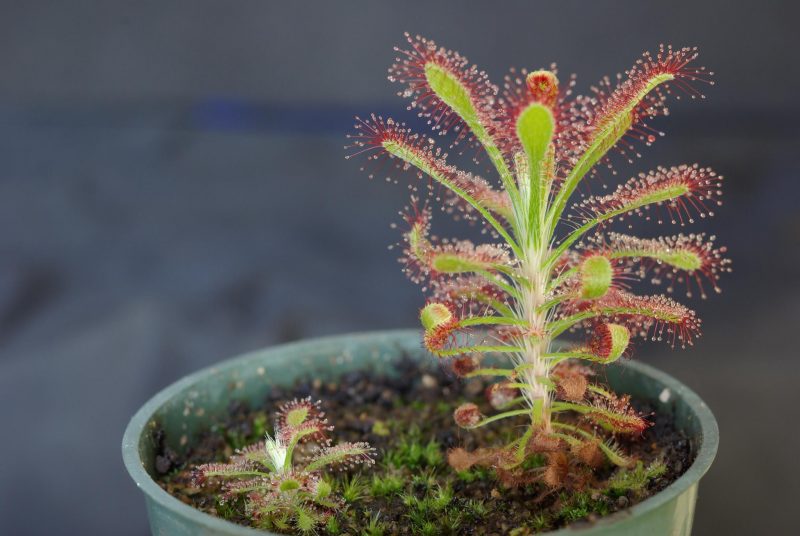
An important point is the lack of fertilizing. Only on very scarce soil will the sundew have its natural appearance as a predator plant. An ordinary weed will grow on fertile soil.
All the substances necessary for growth, the plant produces independently from the captured insects, but can exist for several months without any nutrition at all. Flies are a favorite food, but other insects will do. They must be alive, just caught, for the green predator to agree to eat them.
Caring for sundew at home
If the plant is properly looked after, it can live for more than 10 years in room conditions. Care features are associated with the natural habitat of sundews.
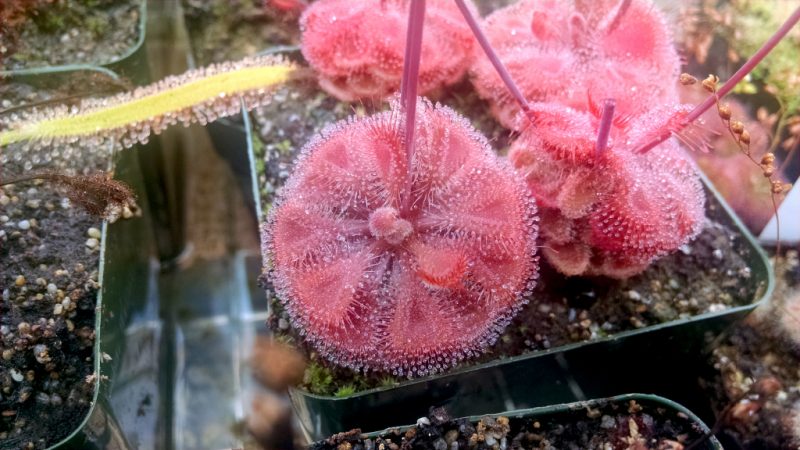
- If the species comes from the tropics, then it does not have a dormant period and in winter it needs additional exposure and high humidity.
- Tuberous sundews with the onset of summer, the rest period begins. They drop leaves and only with a decrease in air temperature in the autumn period again go to growth. Plants do not tolerate frost, but for normal growth, the air in the room where they grow should be cool. Such sundews during sleep are forbidden to water, otherwise the tuber will rot and the plant will not survive.
- Some varieties, on the contrary, fall into sleep in winter. Basically, these are representatives of the temperate climate, which are adapted to changing seasons. In winter, they can discard all or some of the leaves, leaving a wintering bud on the surface of the soil. Watering such sundews is reduced in the cold to a minimum. In the spring, fresh, young leaves will begin to grow.
Lighting and temperature
Rosyanka needs bright lighting for normal development. The requirements for the amount of sunshine consumed depends on the type of plant. For most members of the genus, it takes about five hours to be in direct sunlight, and the rest of the time under bright, diffuse lighting.
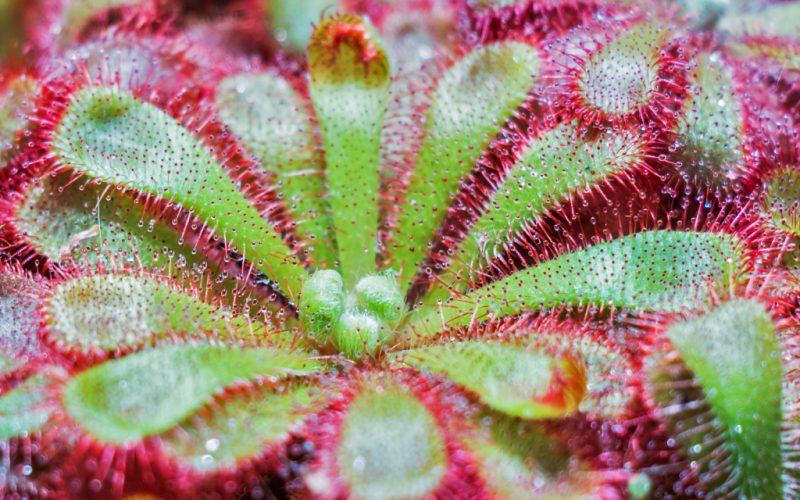
In the hot summer period, direct rays are needed only in the morning and in the evening, but in the afternoon diffused light is preferred. The recommended total length of daylight hours is from 12 to 16 hours. In winter, you can use the backlight with fluorescent lights.
Soil requirement
Marshwort deer prefers poor soil. For growing use a mixture of horse peat and perlite in equal parts. Instead of perlite, you can take sand.Perlite must be soaked in distilled water for several days before being added to peat. After that, prepare the soil for planting. Ready substrate or its components are bought in flower shops.
Watering and humidity
Watering a predator plant is necessary only with distilled or rainwater. It should not contain any mineral salts. If this condition is not met, a sticky liquid that attracts insects will cease to be produced.
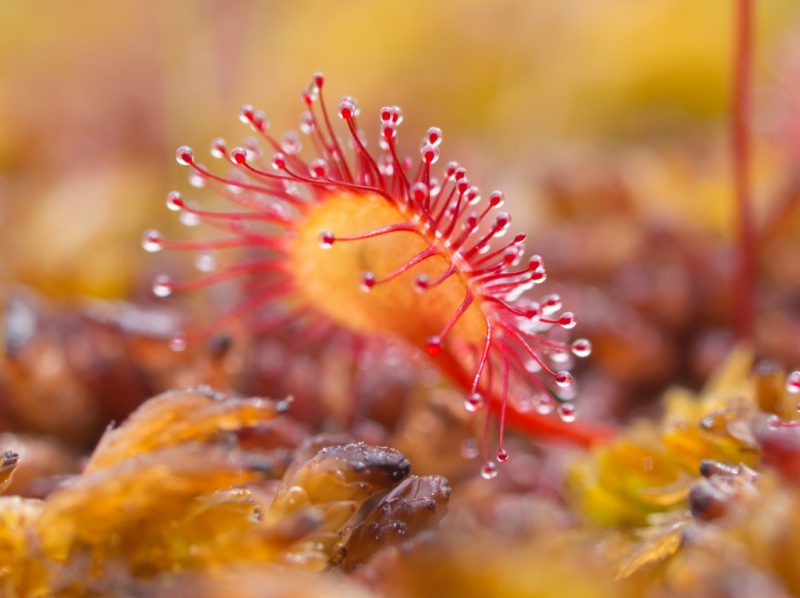
For the formation of droplets of liquid, the sundew needs high humidity, which is difficult to create, because you can’t spray the leaves with water.
It is impossible to water the soil from above, this is done through a pallet. In winter, when the soil dries slowly, the plant is watered 1 time in one and a half or 2 weeks, in the summer - almost every day.
How to transplant a sundew
To grow sundews, a mixture of peat and sand is prepared in equal proportions (acidic soil is needed). Transplanted in the spring when the old pot becomes too small or immediately after purchase in the store. The plant does not need frequent transplants.
The flower pot must be plastic. The ceramic container can interact with acid peat and release salts, which are very harmful to the plant.
The plant is planted in moist soil to reduce stress for it and prevent dry particles of soil from sticking to the leaves.
Sundew plant: reproduction
The plant propagates by seeds and root processes. Old leaves may also take root.
- For seeds make a greenhouse with high humidity.
- Sow seeds in a nutrient-poor substrate so that the usual weed does not grow.
- After sowing on the surface of the soil, the seed is covered with glass until seedlings appear. Maintain high humidity and good lighting.
But the easiest way to breed sundew is to plant siblings. Sibling rosacea forms new plants on the peduncle at the place of contact with the ground.
Diseases, pests and control methods
Sundews are sick most often due to errors in care. Insufficient humidity can cause the leaves to dry out, they do not form “dew”.
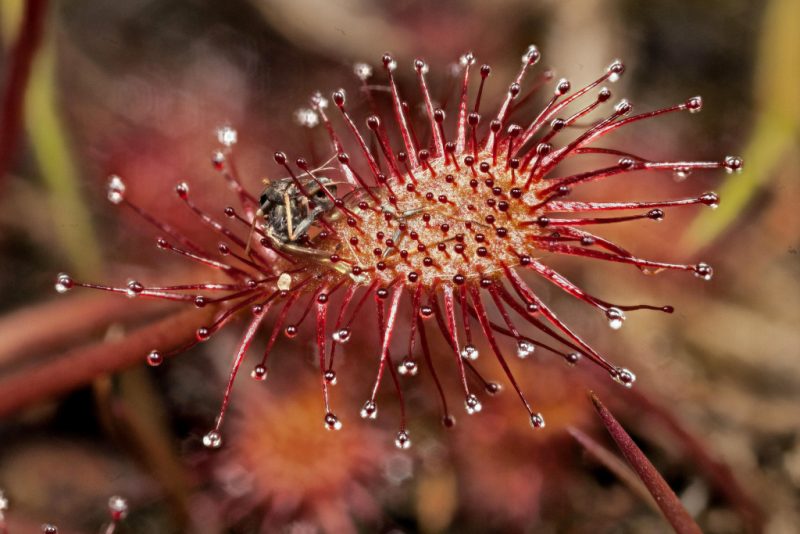
The plant is sick from a lack of lighting, too high air temperature and improper watering. Lighting should be bright, watering - only with distilled water into the pan. It is necessary to take into account the periods of dormancy of the plant and reduce watering when it drops the leaves so that the root does not rot.












